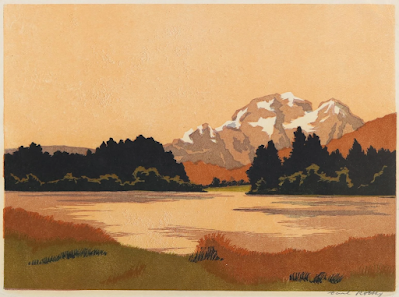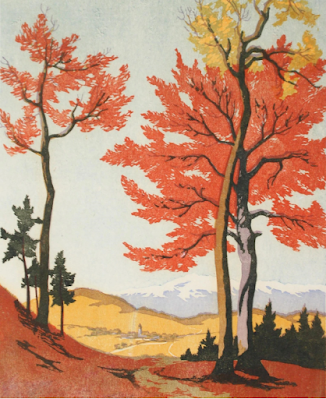If you have always had the impression that Carl Rotky was predictable, you may have to readjust for more than one reason. He is best known for his views of the Styrian mountain countryside in southern Austria where he lived for many years, a pity because there is more to Rotky. His prints are varied and often display the same sense of style as many of his Austrian contemporaries but for some reason his best and most interesting prints still do not come up all that often online and it is not easy to see why.
Rotky's father was an official in the Austro-Hungarian government and disapproved of his son's ambition to become an artist and like so many young men and women of his background, Carl acceded to his father's wish and went to train in medicine in Graz and then at the Charles University in Prague where he graduated in 1914 and soon found himself working as a military surgeon on the eastern front. Despite coming out of the service with a reputation as a good doctor, he returned to his old ambition and took lessons is art in Graz and then Munich. Finally in 1928 he returned to the Kogelberg where his family had lived during the summer months.
So far so good. Or at least that was the case until one day I decided to take one of the two linocuts I own out of their frame. The two prints had come from the collection of someone called Mrs Hockey in Richmond, Surrey, but had not been bought by myself. I was disconcerted to find Rotky had printed the Styrian landscape on heavy card and it looked better in the frame than it did out of it. The mountain landscape was a much better print and I had never intended to remove it from Mrs Hockey's gilded frame but it was obvious that too had been printed on card.
It is not hard to find work printed on paper by Rotky. In fact Bonham's in London mention that one print they were selling was on paper. One one other the paper has cockled and the National Gallery of Australia have a collection of eighty printed on paper though even here it is not easy to tell whether those prints are laid on the back card. I have never come across this before and wonder why an artist like Rotky ever adopted the method because it does not make for a happy outcome. It also will leave anyone wondering how many are on paper and how many are on card. I have not looked at any other museum collections but as prices continue to rise into four figures in Austria and Germany I assume collectors there are content. It is different here in Britain where we have limited access. His work appears in exhibitions advertised by British dealers and like my own were still available in the 1980s and I have been asked to identify his work by dealers in the US.
So it is hard to understand why an artist who was selling his work abroad was using a rather crude method. It may be that he only used card for a time but would help to explain the bold simplicity of the images he is famous for. Printing with any degree of subtly on the heavy card would be a challenge. It would also deter an artist from employing detail. There is also the issue of whether or not he was using both wood or lino. It has always been accepted his made use of lino. The artist himself went as far as to describe his work on his portfolio Salome (above and below) as Farbschnitte or colour-cuts, a term I have never come across until now.
Judge for yourself. Here is Rotky's Hiawatha version of the wanton princess carrying the head of John the Baptist on a dish. As an image it is not unusual in itself for the period but would we have expected it from Rotky? It remains at an extreme but shows that Rotky knew all about contemporary styles. I have already written about the history of linocut in Austria but it makes you wonder what medium Rotky was using and why he chose to describe the work as a colour-cut. There was nothing unusal about lino in Austria after all. Norbertine Bresslern Roth was making a career out of it in nearby Graz.
All this only means there is more to come, including an image of my own mountain scene. He made at least one bookplate for Leo Adler and some of the work above and below does not look like full scale prints. All the same it is intriguing to see Rotky working in this attractive way. There is certainly a lot more available online than there was ten years ago in terms of both images and biography but you will probably guess where this is all heading. Rotky more than anyone needs a proper catalogue and there may well be one in German though somehow I think this is unlikely.
Rotky visited Italy, France and elsewhere but I have found few images that obviously record his travels. The one above of the lagoon at Venice is identifiable only because the topo he depicts was only used in the shallow waters. Otherwise the location would be impossible to guess. Then compare the approach taken by Ethel Kirkpatrick. When she made a colour woodcut showing the lagoon with a topo and wooden mooring posts, you will find an artist sympathetic to her subject but able to employ considerable powers of suggestion. I am not saying you get literal depiction with Rotky but true to Austrian aesthetics of the period, colour and design comes first. Try and imagine a British contemporary of Rotky's printing on heavy card. It isn't possible. Behind Kirkpatrick there is Hiroshige and an understanding of the way images work. (See The boats of Venice )











"Farbschnitt" sounds rather old-fashioned and unspecific in German, too. I have come across the term before, but rarely so. As you point out correctly, Charles, it remains unclear whether it refers to a woodcut or a linocut.
ReplyDeleteKlaus
It makes you wonder what technique he was using. Have you ever come across work printed on card in Germany?
DeleteHardly ever. Some Thiemann, but not Rotky, as far as I remember.
Delete